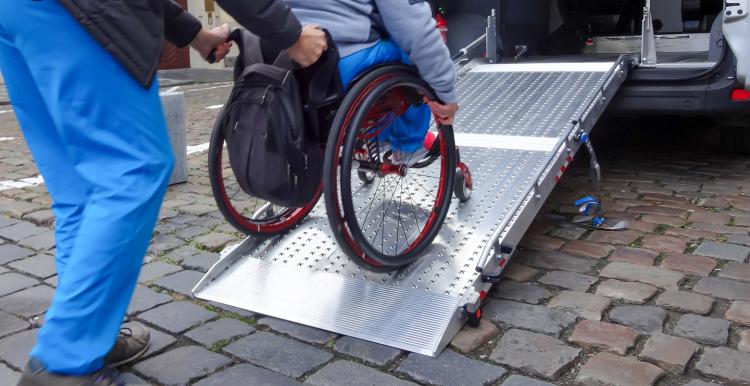We respond to the NHS England consultation on the eligibility criteria for non-emergency patient transport

This article shares edited excerpts from our response to the NHS England consultation, to give a sense of some of the issues involved. Read our full response.
The NHS England and NHS Improvement survey is one part of the consultation on the updated eligibility criteria for non-emergency patient transport. The survey is open until 25 October 2021 and the full consultation document is available on the NHS England website.
Your feedback on non-emergency patient transport
Non-emergency patient transport is only available for a journey to a hospital for treatment or a diagnostic appointment (journeys to community health centres to access hospital-run services are also supported). From conversations with residents, carers, and health and social care colleagues we know that transport eligibility criteria are applied inconsistently within and between services resulting in confusion, inconvenience, missed appointments, and demands on staff time. The decision-making criteria are not transparent or clear. Transport provided does not always match the needs of the residents, and currently (September 2021) there appear to be issues with residents in wheelchairs not being accepted.
Our views on the eligibility criteria for non-emergency patient transport
- Our experience of these services in the last 24 months is that providers are not clear about how some patients meet the criteria and others don’t. The lack of clarity in the wording of existing criteria creates ambiguity, confusion, and unfairness.
- Locally, a resident using UCLH services may qualify for transport, but the same patient doesn’t qualify at Whittington Health or Moorfields. It is clear that current providers are applying different algorithms to identify eligibility and as these are so opaque, patients don’t know why they qualify on one day and not another.
- We would welcome greater transparency of criteria from NHS England and from all providers so that patients who are deemed ineligible are able to understand why and to challenge that decision if it seems incorrect.
- There is greater clarity needed regarding the eligibility of residents in care homes. The way criteria have been applied in Islington has resulted in residents with severe dementia being told to use public transport instead of Non-Emergency Patient Transport Services (NEPTS), or care home staff being expected to leave other duties and take residents to appointments when previously they would have been eligible for NEPTS. This has felt like a shifting of responsibility from the NHS to social care, when social care is not resourced to provide this kind of support. It has resulted in some local people missing appointments to which they were entitled.
- It would also be helpful to have illustrative examples of ‘a medical condition or disability that would compromise [the patient’s] dignity or cause public concern on public transport or in a taxi’. Call handlers are left to make this decision based on an algorithm and a limited understanding of the needs of people with access requirements rather than on the individual’s experience. Someone who is visually impaired may be a regular user of public transport and be very able to access healthcare in this way, whilst for another, this could be a very challenging exercise.
- Providers and call handlers need to demonstrate a broader understanding of the needs of people with medical conditions and disabilities so that appropriate reasonable adjustments can be made when assessing eligibility.
Eligibility criteria around cognitive or sensory impairment
The consultation sets out specific criteria around cognitive and sensory impairment (such as dementia and visual impairment).
We welcome this specific recognition of the needs of people with dementia. However, this needs to be considered alongside the potential need to have a family carer or someone known to the patient attend with them. It feels unfair that being accompanied, to reduce disorientation, could then result in you not meeting the eligibility criteria.
One of our current local transport providers won’t take people with dementia unless they can bring a carer, and as soon as the person says they can bring a carer they are suddenly deemed capable of attending via public transport and ineligible for patient transport.
For those who have cognitive impairment and may be confused about where they are and what is happening, it seems both more practical and more dignified to permit an accompanying carer on patient transport, particularly where journeys are long, complex, or to an unfamiliar location.
However, carers often have needs of their own and clearer guidelines are needed around when a carer taking someone on public transport is appropriate or not. Dementia, for example, is a very wide-ranging condition. For some residents and their carers this could add unnecessary distress.
How to define someone’s ability to ‘self-mobilise’
- In the context of healthcare appointments, the definition of ‘self-mobilise’ needs to relate to the ability to get to the appointment; down the street to the bus stop, on to a bus (or into a taxi if the patient can afford it), and to the healthcare service and into the relevant department. If a person can self-mobilise in this way, then they don’t need patient transport.
- One of the assessment questions asked locally is whether you’ve been able to travel to see your GP in person. However, GPs are generally located closer to people’s homes than hospitals, making this an unfair comparison. And for GPs patients usually have an appointment time, whereas for hospital treatment you might need to be there all day, making finding a family member or friend to accompany you much harder.
- We have heard of a local example where a woman was considered able to self-mobilise because she could walk a few steps, very slowly, to the patient transport from her front door. As a result, the transport offer was withdrawn. NEPTS is commissioned to increase access, not to cause unnecessary stress and missed appointments.
- Likewise, when considering the use of aids and equipment, assessors should consider how regularly patients have used these before the day of the appointment, how confident they feel, and whether relying on this equipment could affect their ability to attend.
Allowing room for discretion doesn't make access fairer
The consultation reinforces the assumption that those with less significant mobility needs should travel independently, but that there should be room for discretion.
We disagree. We are not convinced that discretion facilitates fairness, particularly given existing inequities in the application of criteria. If a journey is overly complex (changing bus more than once, or buses operating less than once an hour), or someone is being discharged in the evening when there is less public transport (rural areas) or transport may feel more intimidating after dark, then why not always include this factor in decision-making, rather than ‘at discretion’. If call handlers were acting in the interests of patients, then the use of discretion would be a positive thing, but it currently feels like discretion is used to refuse people access.
Our experience is that call-handlers are not adept at understanding the needs of residents with disabilities, mobility needs, and other vulnerabilities that could make them eligible for transport services and as such need support to make effective and fair decisions. As such, discretion seems problematic. Alternatively, if we could train and support call-handlers to offer discretion in a way that made the offer more flexible to patient need we would welcome this.
Particularly concerning are limits to taxi costs. Traffic in London (for example) is extremely bad. A short journey can take a very long time depending on the time of day of your appointment. It does not seem right to pass this cost on to patients. Likewise, it penalises people living in more rural areas. If taxis are too expensive, why not ensure that there is sufficient capacity with existing transport services to cover this need.
Patients use non-emergency transport services as a last resort
As patients tell us, you wouldn’t choose this transport if you were able to make your own way because it often takes a long time. The tone of the consultation implies that patients are desperate to take patient transport at any cost, but our experience is that residents do make alternative arrangements if they are able, and it’s those who can’t access in other ways (ie those for whom this service exists) that are using the transport services.


